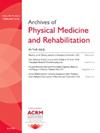外伤性颈脊髓损伤后吞咽困难的危险因素:一项回顾性研究。
IF 3.7
2区 医学
Q1 REHABILITATION
Archives of physical medicine and rehabilitation
Pub Date : 2025-08-01
DOI:10.1016/j.apmr.2024.12.014
引用次数: 0
摘要
目的:外伤性颈脊髓损伤(SCI)患者吞咽困难的病理生理机制尚不清楚。脊髓损伤后发生吞咽困难的几个危险因素包括机械通气、气管造口术、年龄、女性、前路手术入路、脊髓损伤严重程度和多段脊柱融合术。本研究旨在确定外伤性颈椎脊髓损伤患者吞咽困难的危险因素。设计:本回顾性分析包括2013年至2022年间在德国Murnau BG创伤中心接受治疗的个体。候选解释变量,包括损伤严重程度、年龄、神经损伤程度、手术入路、融合脊柱节段数量和气管造口术(包括其类型),采用单变量和多变量统计分析进行分析。结果:我们的分析包括407人,其中22.6%患有吞咽困难。气管切开术和年龄是外伤性颈椎脊髓损伤后吞咽困难的主要危险因素。与先前的文献相反,在考虑了其他因素后,损伤严重程度、前路手术入路、气管造口类型、较高的脊髓损伤程度和多段脊柱融合并没有显示出增加的风险。结论:我们的研究确定年龄和气管切开术是脊髓损伤后吞咽困难的主要危险因素,可以识别有风险的患者并为早期临床管理提供信息。本文章由计算机程序翻译,如有差异,请以英文原文为准。

Risk Factors for Dysphagia After Traumatic Cervical Spinal Cord Injury: A Retrospective Study
Objective
To identify risk factors for dysphagia in individuals who sustained traumatic cervical SCI. The pathophysiologic mechanisms of dysphagia in individuals with traumatic cervical spinal cord injury (SCI) are not well understood yet. Several risk factors for developing dysphagia after SCI were postulated including mechanical ventilation, tracheostomy, age, female sex, anterior surgical approach, SCI severity, and multilevel spinal fusion.
Design
Retrospective analysis: Candidate explanatory variables, including injury severity, age, neurological level of injury, surgical approach, number of fused spinal segments, and tracheostomy including its type, were analyzed using univariate and multivariable statistical analyses.
Setting
We included patients, who were treated at the BG Trauma Center Murnau between 2013 and 2022.
Participants
Datasets of a total of 407 patients with traumatic cervical SCI were included.
Main Outcome Measures
Dysphagia prevalence and identification of associated risk factors.
Results
Our analysis included 407 individuals, of whom 22.6% had dysphagia. Tracheostomy and age were identified as the main risk factors for dysphagia after traumatic cervical SCI. Contrary to previous literature, injury severity, an anterior surgical approach, the type of tracheostomy, a higher neurological level of SCI, and multilevel spinal fusion did not show an increased risk after accounting for other factors.
Conclusions
Our study identifies age and tracheostomy as primary risk factors for dysphagia after SCI, allowing to identify patients at risk and inform early-stage clinical management.
求助全文
通过发布文献求助,成功后即可免费获取论文全文。
去求助
来源期刊
CiteScore
6.20
自引率
4.70%
发文量
495
审稿时长
38 days
期刊介绍:
The Archives of Physical Medicine and Rehabilitation publishes original, peer-reviewed research and clinical reports on important trends and developments in physical medicine and rehabilitation and related fields. This international journal brings researchers and clinicians authoritative information on the therapeutic utilization of physical, behavioral and pharmaceutical agents in providing comprehensive care for individuals with chronic illness and disabilities.
Archives began publication in 1920, publishes monthly, and is the official journal of the American Congress of Rehabilitation Medicine. Its papers are cited more often than any other rehabilitation journal.

 求助内容:
求助内容: 应助结果提醒方式:
应助结果提醒方式:


